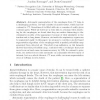Free Online Productivity Tools
i2Speak
i2Symbol
i2OCR
iTex2Img
iWeb2Print
iWeb2Shot
i2Type
iPdf2Split
iPdf2Merge
i2Bopomofo
i2Arabic
i2Style
i2Image
i2PDF
iLatex2Rtf
Sci2ools
MICCAI
2010
Springer
2010
Springer
Model-Based Esophagus Segmentation from CT Scans Using a Spatial Probability Map
Automatic segmentation of the esophagus from CT data is a challenging problem. Its wall consists of muscle tissue, which has low contrast in CT. Sometimes it is filled with air or remains of orally given contrast agent. While air holes are a clear hint to a human when searching for the esophagus, we found that they are rather distracting to discriminative models of the appearance because of their similarity to the trachea and to lung tissue. However, air inside the respiratory organs can be segmented easily. In this paper, we propose to combine a model based segmentation algorithm of the esophagus with a spatial probability map generated from detected air. Threefold cross-validation on 144 datasets showed that this probability map, combined with a technique that puts more focus on hard cases, increases accuracy by 22%. In contrast to prior work, our method is not only automatic on a manually selected region of interest, but on a whole thoracic CT scan, while our mean segmentation
| Added | 29 Jan 2011 |
| Updated | 29 Jan 2011 |
| Type | Journal |
| Year | 2010 |
| Where | MICCAI |
| Authors | Johannes Feulner, Shaohua Kevin Zhou, Martin Huber, Alexander Cavallaro, Joachim Hornegger, Dorin Comaniciu |
Comments (0)

